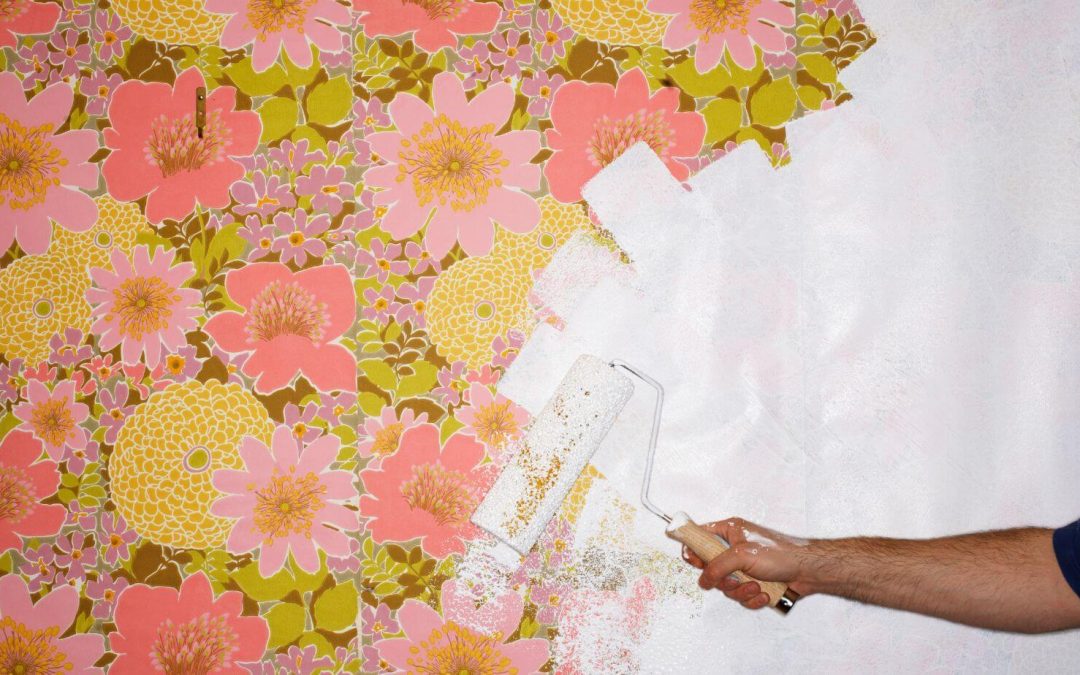Are you tired of the outdated wallpaper in your home? Perhaps you’re looking to freshen up the space with a new coat of paint. But before you dive into your painting project, you might be wondering, “Can you paint over wallpaper?” This article aims to provide you with a comprehensive guide to help you make an informed decision about painting over wallpaper.
Over time, the appearance of wallpapered walls in rooms can become dull for everyone. Moreover, our individual tastes and the color trends and decoration styles in interior design are constantly changing and evolving. If we want to refresh our environment and perhaps liven up our home with a new shade of color, it is not necessarily necessary to consider re-wallpapering in the case of already wallpapered walls. All we need is a paint roller, emulsion paint, and, of course, some caution.
Can You Paint Over Wallpaper?
The question of whether you can paint over wallpaper is a common one among homeowners seeking a cost-effective solution to update their walls. The short answer is yes, you can paint over wallpaper, but it’s important to consider a few factors before proceeding.
Besides traditionally painted walls, it is no coincidence that painted walls are enjoying great popularity. Although it is undeniable that wallpapering work is less tiring compared to painting walls, not to mention that it can also hide minor wall flaws. With the latter, painting over wallpaper becomes child’s play. However, before painting over wallpaper, we must consider whether the wallpaper on the wall is suitable for painting at all. It is important to take into account the adhesion and surface of the material on the wall, as well as the absorbency of the wallpaper. Before starting the work, thoroughly examine the surface you want to paint.
As mentioned above, the adhesion of the wall surface is particularly important in this case, as well as the lifting of the edges, any floating surfaces, holes or separating parts that may have been caused by damage to the wall. Keep in mind that while wallpaper can hide flaws on the wall, there may also be damaged areas on the wallpaper itself that need to be repaired before painting. Minor flaws can usually be easily repaired with filler. If during the preliminary inspection, we find that the material is practically peeling off on its own, it is worth considering whether it is worth reattaching the damaged wallpaper or if it is more practical to remove the entire wallpaper. However, if we decide to restore the damaged areas in the optimal case, we should definitely reattach the lifting parts after undercutting, thus increasing the adhesion for the paint.
Factors to Consider:
Condition of the Wallpaper
Before painting over wallpaper, you should evaluate its condition. If the wallpaper is peeling, damaged, or has a textured surface, it may not be suitable for painting over. In such cases, it’s recommended to remove the wallpaper before painting.
Type of Wallpaper
Different types of wallpaper have different characteristics. Vinyl, fabric-backed, prepasted wallpaper or washable wallpapers are more paint-friendly compared to traditional paper or foil wallpapers. It’s essential to determine the type of wallpaper you have to assess its compatibility with paint.
Adhesion and Smoothness
Paint adheres best to smooth surfaces. If your wallpaper has a textured or embossed pattern, it may affect the overall finish of the painted wall. Smooth wallpapers provide a better base for painting.
Preparation and Priming
Proper preparation is crucial when painting over wallpaper. Thoroughly clean the wallpaper to remove any dirt, dust, or grease. Additionally, applying a high-quality primer can help improve paint adhesion and provide a smooth surface for painting. Using primer is not mandatory when painting over wallpaper. However, I strongly recommend using primer, especially if you want to paint a dark-colored wallpaper to a lighter color.
How to Paint Over Wallpaper
Now that you’ve considered the factors involved, let’s delve into the step-by-step process of painting over wallpaper.
Materials Needed
Before you begin, gather the following materials:
- Drop cloths or plastic sheets
- Painter’s tape
- Sandpaper or sanding block
- Spackling compound
- Primer
- Paint roller and brushes
- Paint tray
- High-quality paint in your desired color
Step 1: Preparation
- Start by clearing the room of furniture and covering the floor with drop cloths or plastic sheets to protect against paint spills.
- Use painter’s tape to carefully mask off any trim, baseboards, or outlets that you don’t want to paint.
- Inspect the wallpaper for any loose edges or damaged areas. If necessary, apply spackling compound to fill in any holes or cracks and sand the surface lightly to achieve a smooth finish.
Step 2: Cleaning
- Thoroughly clean the wallpapered surface using a mild detergent or wallpaper cleaner. This step ensures that the paint adheres well to the wallpaper and removes any dirt or grease that could affect the finish.
- Rinse the surface with clean water and allow it to dry completely before proceeding.
Step 3: Priming
- Apply a high-quality primer to the wallpapered surface. A primer helps the paint adhere better and provides an even base for the topcoat.
- Follow the manufacturer’s instructions for the specific primer you’re using, including drying times between coats.
Step 4: Painting
- Once the primer is dry, you can start painting over the wallpaper. Use a roller or brush to apply the paint evenly, working in sections from top to bottom.
- Apply multiple thin coats of paint rather than one thick coat. This approach ensures better coverage and reduces the chances of the paint peeling or cracking.
- Allow each coat of paint to dry completely before applying the next one. Follow the drying times mentioned on the paint can for optimal results.
- If you’re using multiple paint colors or creating patterns, use painter’s tape to create clean, crisp lines between different sections.
Step 5: Finishing Touches
- Once you’ve achieved the desired color and coverage, carefully remove the painter’s tape while the paint is still slightly wet to avoid any peeling or damage.
- Inspect the painted surface for any touch-ups or areas that may need additional coats of paint. Make sure the overall finish is smooth and even.
- Allow the paint to dry completely according to the manufacturer’s instructions before moving furniture back into the room or making any further modifications.
Not every wallpaper is suitable for painting
Unfortunately, that’s the case! Most homeowners believe that any wallpaper can be painted over during renovations. However, the reality is different, as the success of painting largely depends on the material of the wallpaper on the wall and, as mentioned, the condition of the wallpapered surface. According to experts, primarily lightweight to medium-weight paper wallpapers, sawdust wallpapers, or even glass fiber wallpapers are the materials that allow for painting on them, and with some skill, beautiful painted wall surfaces can be achieved. If the walls of the relevant rooms are covered with vinyl, flock, or embossed wallpapers, it is not recommended to paint them, as they are easily removable and therefore unsuitable for painting. So, if the walls have no major flaws and the wallpaper material allows for painting, the work can begin!
Conclusion
In conclusion, painting over wallpaper can be a viable option to update your walls and give your space a fresh look. However, it’s important to assess the condition of the wallpaper, choose the right type of paint and primer, and follow proper preparation and painting techniques for the best results. Remember to consider the factors discussed in this article and make an informed decision based on your specific situation.
If you’re unsure whether the wallpaper in your home can be painted over or if you prefer to entrust the task to an experienced professional, feel free to reach out! My team and I are happy to repaint or re-wallpaper the walls of your home. With decades of experience and professional tools, we work quickly and beautifully in the city of Saint Augustine, Florida.
Call with confidence, and I will gladly assess the job and provide a free quote! 1(904)217-968
FAQs About Painting Over Wallpaper
Can you paint over vinyl wallpaper?
Yes, painting over vinyl wallpaper is generally possible. However, it’s important to ensure the wallpaper is in good condition and that you use appropriate paint and primer for vinyl surfaces.
Do I need to remove wallpaper glue before painting over wallpaper?
Ideally, it’s recommended to remove any residual wallpaper glue before painting. Wallpaper glue can affect the paint’s adhesion and lead to an uneven finish. Clean the surface thoroughly and use a primer to help mitigate any remaining glue residue.
Can you paint over textured wallpaper?
Painting over textured wallpaper is possible, but it may not result in a smooth finish. The texture of the wallpaper can show through the paint. Consider using a textured paint or skim-coating the wallpaper with joint compound before painting for a smoother appearance.
How long does it take for painted wallpaper to dry?
Drying times vary depending on factors such as humidity, paint type, and the number of coats applied. In general, it can take anywhere from a few hours to a few days for painted wallpaper to dry completely. Refer to the paint manufacturer’s instructions for specific drying times.
Is it necessary to use a primer when painting over wallpaper?
Using a primer is highly recommended when painting over wallpaper. It helps improve paint adhesion, provides a uniform surface, and can prevent the wallpaper pattern from bleeding through the paint.
Can I remove the painted wallpaper in the future?
Yes, painted wallpaper can be removed in the future. However, it might require additional effort compared to removing unpainted wallpaper. You may need to score the painted surface, apply a wallpaper removal solution, and carefully peel or scrape the wallpaper off.
Can You Paint Over Wallpaper Glue?
Painting over wallpaper glue can be a bit more challenging compared to painting over wallpaper itself. The presence of glue residue on the wall can affect the adhesion of the paint and lead to an uneven finish. Ideally, it’s recommended to remove the wallpaper glue before painting for the best results. However, if removing the glue is not feasible or you prefer to paint over it, there are steps you can take to improve the outcome.
Can You Paint Over Patterned Wallpaper?
Painting over patterned wallpaper is indeed possible, but it’s important to consider a few factors before proceeding. The outcome will depend on the condition of the wallpaper, the type of pattern, and the desired result you want to achieve.
Can You Paint Over Wallpaper in a Bathroom?
Painting over wallpaper in a bathroom is possible, but there are a few additional considerations to keep in mind due to the unique conditions of a bathroom environment.
Feel free to give me a call! I’ll do an in-person survey and give you a customized quote! Call now: 1(904)217-9681
Related blog articles:


